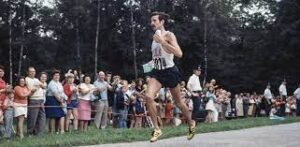 On July 24, 1982, I watched Frank Shorter tie his running shoes. That’s it. At about 7:30 on that warm, clear Saturday morning, I was preparing to run in the Bix 7, an annual 7-mile race in Davenport, Iowa, part of the Bix Jazz Festival. It was during my pre-race stretching and nervous walking around that I observed the shoe tying.
On July 24, 1982, I watched Frank Shorter tie his running shoes. That’s it. At about 7:30 on that warm, clear Saturday morning, I was preparing to run in the Bix 7, an annual 7-mile race in Davenport, Iowa, part of the Bix Jazz Festival. It was during my pre-race stretching and nervous walking around that I observed the shoe tying.
I recognized him immediately. He was the Olympic gold medalist in the marathon in 1972. Every runner at that time recognized Frank Shorter. With his Olympic victory, the only American to ever do that, he essentially created the running phenomenon in this country. And there I was, just a few feet from him on Second Street. I eyed him casually, not wanting to gawk and be conspicuous. He put one foot up on a concrete step, leaned over, and laced up the shoe. Then he did the other. Then it got interesting.
After typing his shoes, he stood, rocked back and forth on the balls of his feet, walked a few strides, and then untied his shoes and started over. After tying them a second time, he went through the same process before unlacing his shoes and typing them for the third time. This time, after testing them, he was satisfied and walked toward the starting line. I followed.
This moment took place in the middle of my short history as a runner. I injured myself a few years later and never ran seriously again. During those years of running, however, I participated in about a dozen races. Well, I can’t say I ever raced. My goal was to finish without stopping in the middle to sit or faint or vomit.
One of my many lessons from running is, the hardest part of running is lacing up your shoes. There were many days I put running in my daily schedule, I planned my route, I had the best running shoes I could afford in my closet, but until I put my feet in the shoes and tied them up, running that day was still an option. I could, and often did, delay indefinitely with numerous excuses and avoidance activities. However, once I put my shoes on and tied them, the decision was made and I was able to go out the door and run.
That is true for so many activities and decisions in life, including writing this story. Until I sit at the computer and put a sentence on the screen, I am in delay mode. Once I got a sentence on the screen, I am writing. The first sentence doesn’t have to be perfect, and it never is. Getting the first sentence written is the important part. I changed the first sentence of this story at least a dozen times. In fact, the first sentence I wrote is no longer the first sentence. It is embedded somewhere in the first couple of paragraphs and no longer resembles that first attempt. Editing is easy. Writing the first sentence, or any sentence that will eventually be changed or deleted is the tough part. Tying up your shoes, even if you untie and retie several times is the crucial part.
 I don’t know why Frank Shorter retied his shoes three times. It may have been a ritual or it may have been necessary. Running at his elite level may have required three attempts. Tying shoes too tight or too loose risks discomfort or even injury. All I know is that I watched in awe as he fussed over his shoes. Do the first thing, and do it well. The rest follows.
I don’t know why Frank Shorter retied his shoes three times. It may have been a ritual or it may have been necessary. Running at his elite level may have required three attempts. Tying shoes too tight or too loose risks discomfort or even injury. All I know is that I watched in awe as he fussed over his shoes. Do the first thing, and do it well. The rest follows.
Incidentally, I was approximately the 2300th runner out of 3500 to cross the finish line that day. I was tired, jubilant, and ran the 7 miles in just under one hour. Frank Shorter finished third in about half that time. I suspect his shoes were just right.
2 Comments until now
Beautifully written story John Powell ~ !!!
Love this perspective!
Add your Comment!